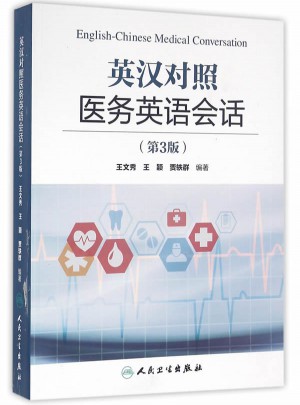
英漢對(duì)照醫(yī)務(wù)英語會(huì)話(第3版)
- 所屬分類:圖書 >外語>行業(yè)英語>醫(yī)學(xué)英語
- 作者:[王文秀],[王穎],[賈軼群]編著
- 產(chǎn)品參數(shù):
- 叢書名:--
- 國(guó)際刊號(hào):9787117221474
- 出版社:人民衛(wèi)生出版社
- 出版時(shí)間:2016-05
- 印刷時(shí)間:2016-05-01
- 版次:3
- 開本:16開
- 頁數(shù):--
- 紙張:膠版紙
- 包裝:平裝-膠訂
- 套裝:否

1.力求實(shí)用 特別強(qiáng)調(diào)了醫(yī)務(wù)英語會(huì)話在各種真實(shí)場(chǎng)景和醫(yī)療場(chǎng)合的實(shí)際運(yùn)用,使學(xué)習(xí)者在掌握語言技能的同時(shí),能夠在模擬診療的環(huán)境中操練英語交際技能,了解和鞏固相關(guān)的醫(yī)學(xué)知識(shí)。
2.具有針對(duì)性 語言素材的選擇符合從醫(yī)人員和相關(guān)學(xué)習(xí)者的特點(diǎn)和實(shí)際水平,并充分考慮到從醫(yī)人員面對(duì)外籍患者可能產(chǎn)生的表達(dá)困難,從關(guān)鍵且容易理解的醫(yī)學(xué)背景知識(shí)切入主題,從不同角度舉一反三地操練聽說技能,提高其醫(yī)療英語的應(yīng)用能力。
3.涵蓋多元文化 《英漢對(duì)照醫(yī)務(wù)英語會(huì)話(第3版)》提供的各類醫(yī)療文化場(chǎng)景將幫助醫(yī)務(wù)人員正確面對(duì)和處理外籍患者所注重的文化和傳統(tǒng)觀念。
part 1 Medicine 醫(yī)學(xué)篇
Unit I Diseases and Symptoms 疾病和癥狀
1.Pain疼痛
2.Headache頭痛
3.Insomnia失眠
4.Depression抑郁
5.Mental Disorder心理障礙
6.Edema水腫
7.Burn燒傷
8.Infection感染
9.Disease疾病
10.Heart Disease心臟病
11.Thyroiditis甲狀腺炎
12.Cancer癌
13.Tumor腫瘤
14.Leukemia白血病
15.Rheumatic Fever風(fēng)濕熱
16.SARS嚴(yán)重急性呼吸綜合征(非典)
17.The AIDS艾滋病
18.Allergy過敏
19.Anxiety Disorder焦慮疾病
20.Obesity肥胖癥
21.Geriatric Diseases老年疾病
22.Dementia癡呆
23.Chronic Diseases慢性疾病
Unit II Treatment 治療
1.Diagnosis診斷
2.Treatment治療
3.Drug藥物
4.Operation手術(shù)
5.Rehabilitation康復(fù)
6.First Aid急救
7.ICU重癥監(jiān)護(hù)室
8.Community Health社區(qū)保健
UnitIII Case Discussion病案討論
1.Influenza流行性感冒
2.Pneumonia肺炎
3.Myocardial Infarction心肌梗死
4.Idiopathic Thrombocytopenic Purpura(ITP)特發(fā)性血小板減少性紫癜
5.Hypothyroidism甲狀腺功能減退
6.Duodenal Ulcer十二指腸潰瘍
7.Acute Pancreatitis急性胰腺炎
8.Cirrhosis ofLiver肝硬化
9.Hepatic Coma肝性腦病
10.Rheumatic Fever風(fēng)濕熱
11.Tetanus破傷風(fēng)
12.Fracture骨折
13.Tumor ofthe Breast乳腺腫瘤
14.Trichomonas Vaginitis滴蟲性陰道炎
15.Placenta Previa前置胎盤
16.Measles麻疹
17.Scarlet Fever猩紅熱
18.Areosinusitis航空性鼻竇炎
19.Psoriasis銀屑病(牛皮癬)
20.Consultation會(huì)診
Unit IV Laboratory Tests and Other Diagnostic Methods檢驗(yàn)室檢查和其他診斷方法
1.Hematological Examinations血液學(xué)檢查
2.Examinations ofUrine and Stool尿液糞便檢查
3.X-ray Examination X線檢查
4.Magnetic Resonance Imaging(MRI)磁共振成像
5.Endoscopy內(nèi)鏡檢查
6.Laparoscopy腹腔鏡檢查
Unit ⅤTherapies療法
1.Lasers激光
2.Physiotherapy理療
Part 2 Medical Service 醫(yī)療服務(wù)篇
Unit I Sentences Commonly Used in Hospital醫(yī)院內(nèi)常用語
Unit II Seeing a Doctor and First Visit看病和出診
Unit III Internal Medicine內(nèi)科
Unit IV Surgery外科
Unit V Obstetrics and Gynecology婦產(chǎn)科
Unit VI Pediatrics兒科
Unit VII Neurology and Psychiatry神經(jīng)精神科
Unit VIII Ophthalmology眼科
Unit IX Otorhinolaryngology耳鼻喉科
Unit X Stomatology口腔科
Unit XI Dermatology皮膚科
Unit XII Health Instruction健康指導(dǎo)
Unit XVIII Nursing護(hù)理
Unit XIV Other topics其他
Unit XV Death死亡
主要參考書目
《英漢對(duì)照醫(yī)務(wù)英語會(huì)話(第3版)》:
10. Heart Disease
心臟病
Student:Is heart disease a major killer in the world?
學(xué)生: 心臟病是世界上的主要?dú)⑹謫幔?/p>
Professor:Yes. About one half of all deaths in the U.S. are caused by heart attack, strokes, and other diseases of the heart and blood vessels.
教授: 是的。由心肌梗死、卒中以及心臟和血管的其他疾病引起的死亡人數(shù)占美國(guó)所有死亡人數(shù)的二分之一。
Student:What do heart diseases involve?
學(xué)生: 心臟病包括哪些疾病?
Professor:Heart diseases involve congenital heart disease, coronary heart disease, myocardial infarction and so on.
教授: 心臟病包括先天性心臟病、冠心病、心肌梗死等。
Student: It is said congenital heart disease is often divided into two types, isn't it?
學(xué)生: 據(jù)說先天性心臟病通常分為兩種,是嗎?
Professor:Yes. Those with cyanosis and those without cyanosis.
教授: 是的。分為發(fā)紺型和非發(fā)紺型。
Student:What are the symptoms ofthe cyanotic and the non-cyanotic?
學(xué)生: 發(fā)紺型和非發(fā)紺型有什么癥狀呢?
Professor:The cyanotic includes tetralogy of Fallot, transposition of the great vessels, tricuspid atresia, etc.
教授: 發(fā)紺型有法洛四聯(lián)癥、大動(dòng)脈異位、三尖瓣閉鎖等癥狀。
Professor:The non-cyanotic covers atrial septal defect, patent ductus arteriosus, aortic stenosis, pulmonic stenosis, etc.
教授: 非發(fā)紺型有心房隔膜缺損、動(dòng)脈導(dǎo)管未閉、動(dòng)脈狹窄、肺動(dòng)脈狹窄等癥狀。
Student: Is it likely that hereditary factors play a role in congenital heart disease?
學(xué)生: 遺傳因素有可能對(duì)先天心臟病起一定的作用嗎?
Professor:It is hard to say. But experts believe that some prescription and over the counter drugs and alcohol during pregnancy increase the risk ofheart defects.
教授: 很難說。但是專家們認(rèn)為懷孕期間一些處方和非處方藥以及酒精都會(huì)增加患心臟病的危險(xiǎn)。
Student:What causes coronary heart disease(CHD)?
學(xué)生: 冠心病是由什么引起的?
Professor:It is caused by a thickening of the inside walls of the coronary arteries. High blood cholesterol, high blood pressure and smoking also contribute to CHD.
教授: 冠心病是由冠狀動(dòng)脈內(nèi)壁增厚所引起的。膽固醇高,高血壓和吸煙也會(huì)導(dǎo)致冠心病。
Student:It is believed that chest pain or shortness of breath may be the earliest signs of CHD, isn't it?
學(xué)生: 有人認(rèn)為胸痛和氣短是冠心病的早期征兆,是嗎?
Professor:Yes,A person may feel heaviness, tightness, pain, burning, pressure, or squeezing usually behind the breastbone.
教授: 是的。患者可能會(huì)感到胸骨后出現(xiàn)沉重感、緊縮感、疼痛、燒灼感和壓迫感。
Student:What kind oflifestyle changes can help a person with heart disease?
學(xué)生: 什么樣的生活方式改變對(duì)心臟病患者有好處?
Professor:Changing one's diet to keep low in fat and calories will help reduce high blood cholesterols.
教授: 改變飲食習(xí)慣,減少脂肪和熱量的攝入,將有助于降低血膽固醇。
Student:Anything else?
學(xué)生: 還有呢?
Professor:Quitting smoking dramatically lowers the risk of a heart attack, and moderate amounts ofphysical activity will benefit.
教授: 戒煙能在很大程度上降低心臟病發(fā)作的概率。適當(dāng)?shù)倪\(yùn)動(dòng)也是有益的。
……
非常滿意
跟想要的不太一樣
很實(shí)用,希望對(duì)自己學(xué)習(xí)有幫助
不錯(cuò),紙質(zhì)非常好,正版。內(nèi)容喜歡,
都沒包裝好,收到書已經(jīng)壞了,心疼半天
一買完就降價(jià)了
包裝有些破損,書有些臟,不是當(dāng)當(dāng)?shù)娘L(fēng)格呀!
內(nèi)容豐富,適合各類臨床工作所需,物超所值,非常實(shí)用。
Satisfied
有用途,內(nèi)容不錯(cuò)